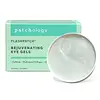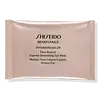What's inside
What's inside
 Key Ingredients
Key Ingredients

 Benefits
Benefits

 Concerns
Concerns

 Ingredients Side-by-side
Ingredients Side-by-side

Water
Skin ConditioningGlycerin
HumectantDipropylene Glycol
HumectantCeratonia Siliqua Gum
EmollientChondrus Crispus Powder
AbrasiveButylene Glycol
HumectantChondrus Crispus Extract
Skin ConditioningPanthenol
Skin ConditioningCentella Asiatica Extract
CleansingPaeonia Suffruticosa Root Extract
Skin ProtectingChamomilla Recutita Flower Extract
MaskingPortulaca Oleracea Extract
Skin ConditioningCaffeine
Skin ConditioningHydrolyzed Collagen
EmollientCocos Nucifera Fruit Extract
EmollientSodium Hyaluronate
HumectantAloe Barbadensis Leaf Extract
EmollientLonicera Japonica Flower Extract
Skin ConditioningCalendula Officinalis Extract
Skin ConditioningLavandula Angustifolia Extract
Skin ConditioningSyringa Vulgaris Extract
Skin ConditioningRosmarinus Officinalis Extract
AntimicrobialMentha Arvensis Leaf Extract
MaskingMonarda Didyma Leaf Extract
Skin ConditioningJasminum Officinale Extract
MaskingFreesia Refracta Extract
Skin ConditioningAcetyl Tetrapeptide-5
HumectantTrideceth-6
EmulsifyingBetaine
Humectant1,2-Hexanediol
Skin ConditioningCellulose Gum
Emulsion StabilisingXanthan Gum
EmulsifyingGlyceryl Caprylate
EmollientPotassium Chloride
Sodium Polyacrylate
AbsorbentSucrose
HumectantEthylhexylglycerin
Skin ConditioningSynthetic Fluorphlogopite
Polysorbate 20
EmulsifyingHydrogenated Polydecene
EmollientDipotassium Glycyrrhizate
HumectantAllantoin
Skin ConditioningPantolactone
HumectantPolyglutamic Acid
Skin ConditioningAcetyl Glucosamine
Skin ConditioningUrea
BufferingYeast Amino Acids
HumectantTrehalose
HumectantInositol
HumectantTaurine
BufferingPotassium Sorbate
PreservativeGlutathione
Disodium EDTA
Phenoxyethanol
PreservativeCI 77891
Cosmetic ColorantMica
Cosmetic ColorantParfum
MaskingWater, Glycerin, Dipropylene Glycol, Ceratonia Siliqua Gum, Chondrus Crispus Powder, Butylene Glycol, Chondrus Crispus Extract, Panthenol, Centella Asiatica Extract, Paeonia Suffruticosa Root Extract, Chamomilla Recutita Flower Extract, Portulaca Oleracea Extract, Caffeine, Hydrolyzed Collagen, Cocos Nucifera Fruit Extract, Sodium Hyaluronate, Aloe Barbadensis Leaf Extract, Lonicera Japonica Flower Extract, Calendula Officinalis Extract, Lavandula Angustifolia Extract, Syringa Vulgaris Extract, Rosmarinus Officinalis Extract, Mentha Arvensis Leaf Extract, Monarda Didyma Leaf Extract, Jasminum Officinale Extract, Freesia Refracta Extract, Acetyl Tetrapeptide-5, Trideceth-6, Betaine, 1,2-Hexanediol, Cellulose Gum, Xanthan Gum, Glyceryl Caprylate, Potassium Chloride, Sodium Polyacrylate, Sucrose, Ethylhexylglycerin, Synthetic Fluorphlogopite, Polysorbate 20, Hydrogenated Polydecene, Dipotassium Glycyrrhizate, Allantoin, Pantolactone, Polyglutamic Acid, Acetyl Glucosamine, Urea, Yeast Amino Acids, Trehalose, Inositol, Taurine, Potassium Sorbate, Glutathione, Disodium EDTA, Phenoxyethanol, CI 77891, Mica, Parfum
Water
Skin ConditioningButylene Glycol
HumectantPentaerythrityl Tetraethylhexanoate
EmollientDiphenylsiloxy Phenyl Trimethicone
Skin ConditioningGlycerin
HumectantDipropylene Glycol
HumectantPEG-60 Hydrogenated Castor Oil
EmulsifyingTocopheryl Acetate
AntioxidantPhenoxyethanol
PreservativeAlcohol
AntimicrobialCarbomer
Emulsion StabilisingSodium Citrate
BufferingParfum
MaskingBHT
AntioxidantSqualane
EmollientXanthan Gum
EmulsifyingPotassium Hydroxide
BufferingRetinol
Skin ConditioningPolysorbate 20
EmulsifyingCitric Acid
BufferingTrisodium EDTA
Magnesium Ascorbyl Phosphate
AntioxidantButylphenyl Methylpropional
PerfumingSapindus Mukorossi Peel Extract
Skin ConditioningLimonene
PerfumingLinalool
PerfumingUncaria Gambir Extract
AstringentCitronellol
PerfumingAlpha-Isomethyl Ionone
PerfumingPaeonia Suffruticosa Root Extract
Skin ProtectingGeraniol
PerfumingBenzyl Benzoate
AntimicrobialSodium Acetylated Hyaluronate
HumectantHydroxyproline
Skin ConditioningChlorella Vulgaris Extract
Skin ConditioningCI 75130
Cosmetic ColorantWater, Butylene Glycol, Pentaerythrityl Tetraethylhexanoate, Diphenylsiloxy Phenyl Trimethicone, Glycerin, Dipropylene Glycol, PEG-60 Hydrogenated Castor Oil, Tocopheryl Acetate, Phenoxyethanol, Alcohol, Carbomer, Sodium Citrate, Parfum, BHT, Squalane, Xanthan Gum, Potassium Hydroxide, Retinol, Polysorbate 20, Citric Acid, Trisodium EDTA, Magnesium Ascorbyl Phosphate, Butylphenyl Methylpropional, Sapindus Mukorossi Peel Extract, Limonene, Linalool, Uncaria Gambir Extract, Citronellol, Alpha-Isomethyl Ionone, Paeonia Suffruticosa Root Extract, Geraniol, Benzyl Benzoate, Sodium Acetylated Hyaluronate, Hydroxyproline, Chlorella Vulgaris Extract, CI 75130
Ingredients Explained
These ingredients are found in both products.
Ingredients higher up in an ingredient list are typically present in a larger amount.
Butylene Glycol (or BG) is used within cosmetic products for a few different reasons:
Overall, Butylene Glycol is a safe and well-rounded ingredient that works well with other ingredients.
Though this ingredient works well with most skin types, some people with sensitive skin may experience a reaction such as allergic rashes, closed comedones, or itchiness.
Learn more about Butylene GlycolDipropylene Glycol is a synthetically created humectant, stabilizer, and solvent.
This ingredient helps:
Dipropylene glycol is technically an alcohol, but it belongs to the glycol family (often considered part of the ‘good’ alcohols). This means it is hydrating and gentle on skin unlike drying solvent alcohols like denatured alcohol.
As a masking agent, Dipropylene Glycol can be used to cover the smell of other ingredients. However, it does not have a scent.
Studies show Dipropylene Glycol is considered safe to use in skincare.
Learn more about Dipropylene GlycolGlycerin is already naturally found in your skin. It helps moisturize and protect your skin.
A study from 2016 found glycerin to be more effective as a humectant than AHAs and hyaluronic acid.
As a humectant, it helps the skin stay hydrated by pulling moisture to your skin. The low molecular weight of glycerin allows it to pull moisture into the deeper layers of your skin.
Hydrated skin improves your skin barrier; Your skin barrier helps protect against irritants and bacteria.
Glycerin has also been found to have antimicrobial and antiviral properties. Due to these properties, glycerin is often used in wound and burn treatments.
In cosmetics, glycerin is usually derived from plants such as soybean or palm. However, it can also be sourced from animals, such as tallow or animal fat.
This ingredient is organic, colorless, odorless, and non-toxic.
Glycerin is the name for this ingredient in American English. British English uses Glycerol/Glycerine.
Learn more about GlycerinPaeonia Suffruticosa Root Extract comes Peony plant. It has anti-inflammatory and antioxidant properties.
Emerging studies also show peony root may help reduce hyperpigmentation.
Ancient Chinese medicine has used peony root to treat dark spots, but studies are looking into this claim more.
Learn more about Paeonia Suffruticosa Root ExtractParfum is a catch-all term for an ingredient or more that is used to give a scent to products.
Also called "fragrance", this ingredient can be a blend of hundreds of chemicals or plant oils. This means every product with "fragrance" or "parfum" in the ingredients list is a different mixture.
For instance, Habanolide is a proprietary trade name for a specific aroma chemical. When used as a fragrance ingredient in cosmetics, most aroma chemicals fall under the broad labeling category of “FRAGRANCE” or “PARFUM” according to EU and US regulations.
The term 'parfum' or 'fragrance' is not regulated in many countries. In many cases, it is up to the brand to define this term.
For instance, many brands choose to label themselves as "fragrance-free" because they are not using synthetic fragrances. However, their products may still contain ingredients such as essential oils that are considered a fragrance by INCI standards.
One example is Calendula flower extract. Calendula is an essential oil that still imparts a scent or 'fragrance'.
Depending on the blend, the ingredients in the mixture can cause allergies and sensitivities on the skin. Some ingredients that are known EU allergens include linalool and citronellol.
Parfum can also be used to mask or cover an unpleasant scent.
The bottom line is: not all fragrances/parfum/ingredients are created equally. If you are worried about fragrances, we recommend taking a closer look at an ingredient. And of course, we always recommend speaking with a professional.
Learn more about ParfumPhenoxyethanol is a preservative that has germicide, antimicrobial, and aromatic properties. Studies show that phenoxyethanol can prevent microbial growth. By itself, it has a scent that is similar to that of a rose.
It's often used in formulations along with Caprylyl Glycol to preserve the shelf life of products.
Polysorbate 20 is made by combining ethoxylation of sorbitan, ethylene oxide, and lauric acid. It is a mild cleansing agent, surfactant, and emulsifier.
As a surfactant, it helps collect dirt and oils for washing. Emulsifiers prevent oils and water from separating.
Polysorbate 20 also adds scent to a product. Since it is made using sorbitol, it has a sweet scent. Sorbitol can also be found in fruits such as apples and peaches.
The lauric acid used to create Polysorbate 20 is often derived from coconuts.
Polysorbate 20 may not be fungal acne safe.
Learn more about Polysorbate 20Water. It's the most common cosmetic ingredient of all. You'll usually see it at the top of ingredient lists, meaning that it makes up the largest part of the product.
So why is it so popular? Water most often acts as a solvent - this means that it helps dissolve other ingredients into the formulation.
You'll also recognize water as that liquid we all need to stay alive. If you see this, drink a glass of water. Stay hydrated!
Learn more about WaterXanthan gum is used as a stabilizer and thickener within cosmetic products. It helps give products a sticky, thick feeling - preventing them from being too runny.
On the technical side of things, xanthan gum is a polysaccharide - a combination consisting of multiple sugar molecules bonded together.
Xanthan gum is a pretty common and great ingredient. It is a natural, non-toxic, non-irritating ingredient that is also commonly used in food products.
Learn more about Xanthan Gum